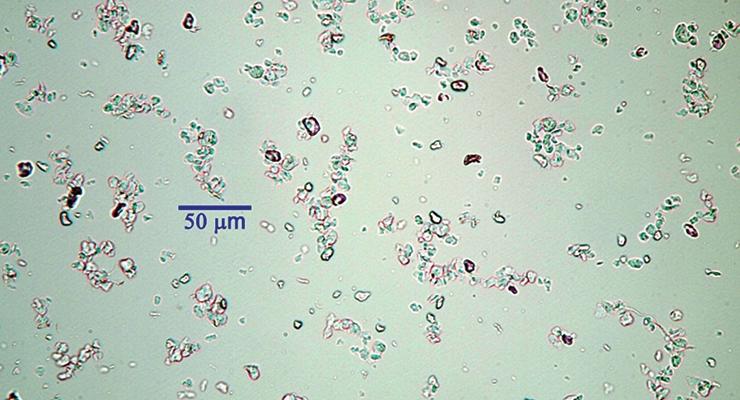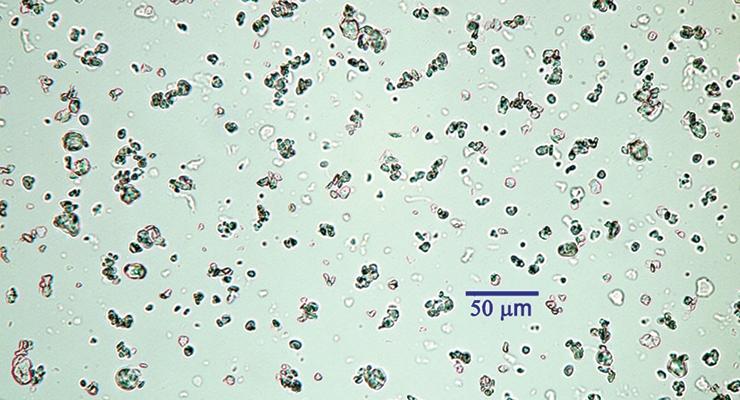By Bill Neuberg , Shamrock Technologies Chairman and Technical Director | 23.01.17
(L) 10% PTFE, 90% WAX IN CEDAR OIL – INDEX 1.515 (R) 10% PTFE, 90% WAX IN 1.40 INDEX LIQUID
Identification of particles is routinely done by specialists in polarizing light microscopy. This science is otherwise known as optical crystallography.
To distinguish one known particle from another known particle, we can take a simple approach that doesn’t require polarized light, just a good microscope that can be purchased on eBay for under a thousand dollars, perhaps much under. This and some reference liquids of known refractive index allow you to determine the index of the particle.
The index of refraction of a material is defined by the speed of light in vacuum, c, divided by the speed of light through the material, v. This results in an index of 1.333 for water. If you used v divided by c, it would show that light travels through water at 75% the speed in a vacuum.
There are published tables for the refractive index of many liquids. To find the refractive index of a solid, you need to make it disappear by immersing it in a liquid of known index. To do this with a microscope, you can buy refractive index liquids or get pretty close by using available liquids having a refractive index found on the Internet.
Let’s take the example of a mixture of wax and PTFE. A quick search shows the refractive index to be 1.35–1.38. The range is not because the material is that variable, but because it exists in a crystal form in which light is slowed differently in different directions. Only materials in the cubic crystal system have only one refractive index. Next, a determination of the index of a commonly used wax, using the index liquids from Cargile Labs, shows it to be in the range of 1.54. Going to a table on common liquids, we see that Cedarwood oil has an index of 1.515. This appears to be a little closer to wax than to PTFE, but in between. A visit to Amazon shows one oz. for $6.75.
Prepare a microscope slide using a tiny spec of wax and even less of PTFE wet with a drop of Cedar Oil. Slide a cover slip around to disperse the particles and take a look. The particles should be well separated. If they are not, add more oil.
Now, set up your microscope condenser for Koehler illumination, which is nicely described on the Internet. The aperture diaphragm in the condenser is used to control resolution or contrast. Close the aperture to obtain maximum contrast. This produces a halo around a particle when the microscope is focused down toward the substance of lower index (or up toward that of higher index). This halo is known as the Becke line and more details are also on the Internet.
The PTFE particles appear dark because their refractive index is not close to that of the liquid. Conversely, the same combination of wax and PTFE mounted in ethylene glycol momethyl ether shows the PTFE particles almost disappearing because the index of the particles is close to that of the liquid.
A microscope can also be calibrated to determine particle size. In fact, this is the reference standard for the calibration of other size measuring instruments. McCrone Research Institute provides excellent courses in all phases of microscopy.
Here are some refractive index liquids:
• 1.373 – Ethyl butyrate
• 1.39 – Hexane, Kerosene
• 1.40 – Ethylene glycol momethyl ether
• 1.42 – Ethylene glycol monobutyl ether
• 1.502 – Benzene
• 1.515 – Cedarwood oil, Anisol
• 1.53 – Monochlorobenzene, Clove oil
Refractive Index and Polarized Light
Polarized light microscopy makes use of the double refractive properties of crystalline materials except for a few in the cubic crystal system. Look at your cell phone and imagine it to be transparent, but having three refractive indices corresponding to the dimensions you see. You now can recognize that light will travel faster through the thin dimension than the length or width.
Colors are produced by the difference in speed of the fast and slow rays of light. This is known as birefringence, signifying double refraction and produces interference colors similar to what you see from an oil slick on water – not the colors of the rainbow. An interference color chart called the Michel-Levy Birefringence Chart can be found online. This allows you to determine the thickness of a particle if you know the birefringence, or the other way around.
The wax and PTFE particles in the above photos appear white when viewed with crossed polars, but colors can be brought out by adding a wave plate to the light path. Much more information is at hand online. Although the speed of light in a vacuum is constant, an observer on Earth may be moving toward or away from its source. Einstein came up with a theory of relativity to address this.
William B. Neuberg graduated Rennsselaer Polytechnic Institute in 1954 with a degree in chemistry. After graduating, he served in the US Navy as a naval aviator for five years. After serving his country, William joined his father’s business, Shamrock Technologies, and proceeded to develop micronized wax and the use of PTFE in printing ink. William has published his previous research on the mechanisms of rub resistance.

